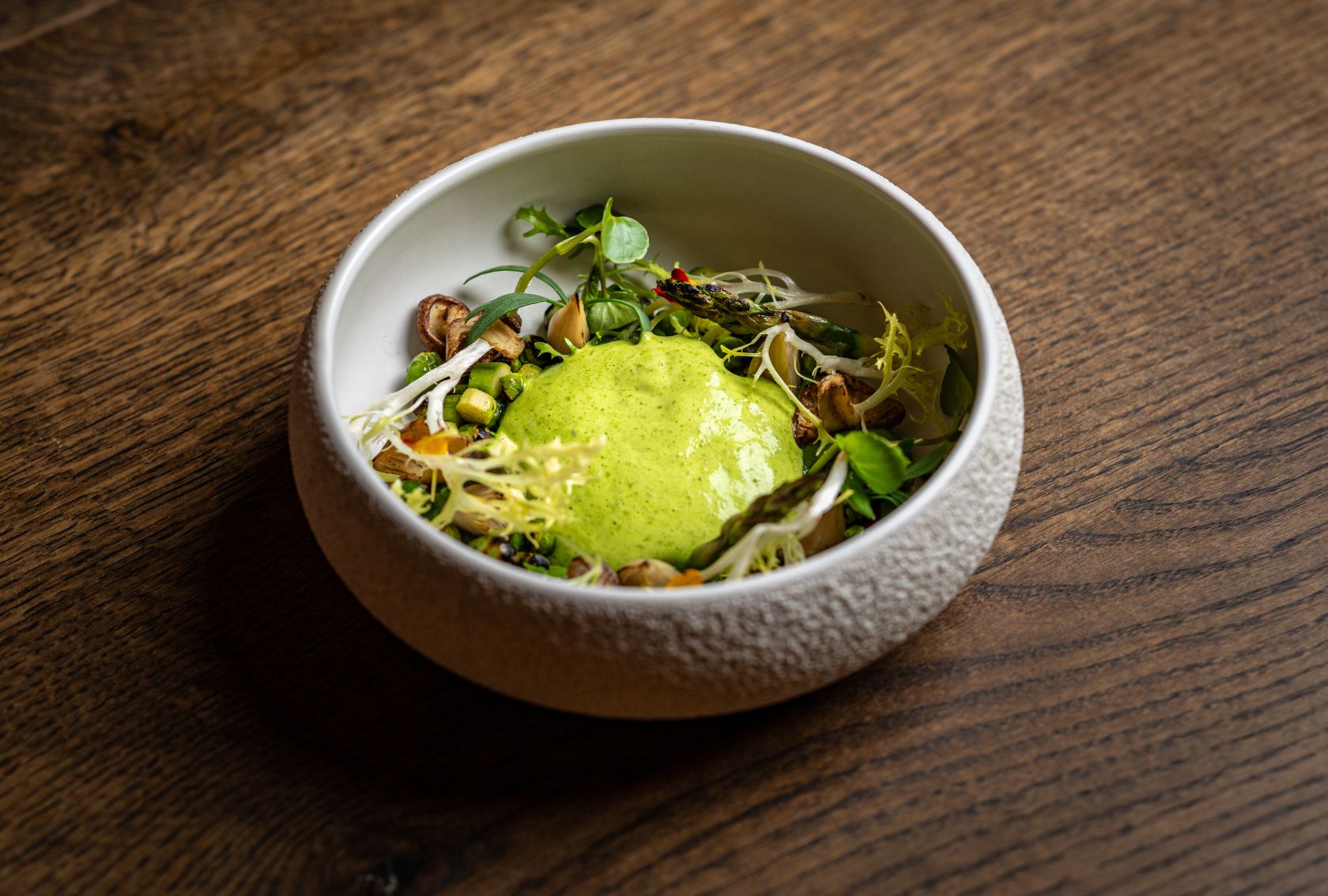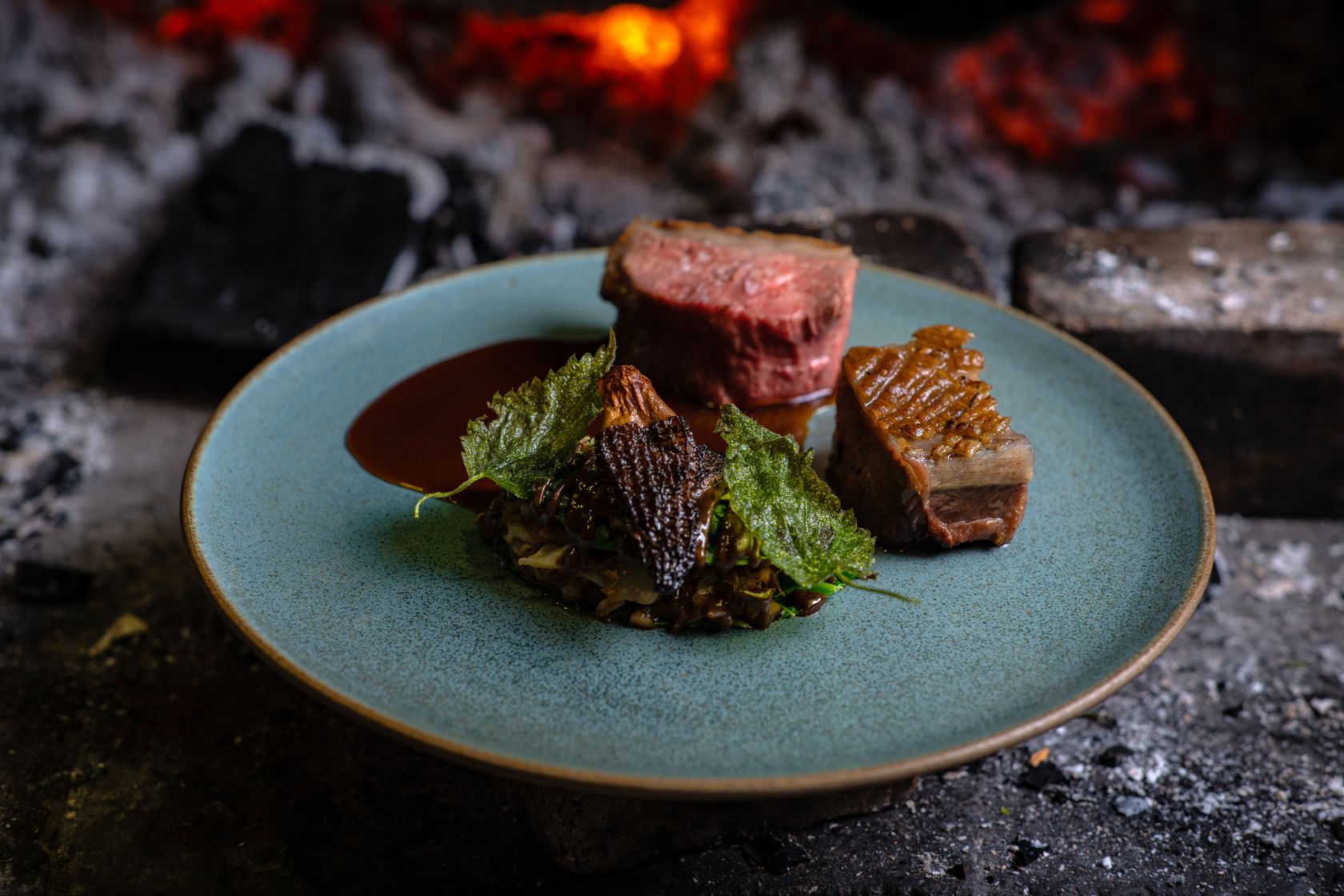Head chef Luca Mastrantoni sends a long stick with a metal cone filled with dry-aged beef fat into a roaring open fire, setting the whole thing alight, before hovering it over the oyster I’m about to eat.
What’s known as ‘flambadou’ is an ancient Swedish cooking technique, used by the indigenous Sámi people of the north of the country, and revived by chef patron Niklas Ekstedt. It gives the oyster a unique, rich finish, served alongside beurre blanc here at his UK restaurant Ekstedt at The Yard.
“I found [the device] in an drawing in an old book,” explains Ekstedt. “We heat it up until it’s very, very hot, then we light the fat and everything almost explodes, and the fat drips down to whatever we’re cooking.”
Today, Sámi communities inhabit parts of Sweden, Norway, Finland and Russia and in Sweden many live in Swedish lapland as nomads, most travelling with reindeer herds.
“It’s a history and a legacy that not that a lot of people know about in Europe,” says Ekstedt. “Their food is very based on being out on the mountain. They have long times without so it’s very either a dish that’s cooked very quickly on the fire, like the heart or the blood, and eaten immediately, or it’s meat that’s very thick, dried and either smoked or salted heavily.”
Inspired by the indigenous communities and the forests and mountains where he grew up in Åre, Jämtland, the 46-year-old chef has made a name for himself taking food preparation back to its most primitive – using fire only.
Head to his one Michelin star Stockholm restaurant and you’ll find a professional fine dining kitchen with no absolutely no electricity or gas.
Many chefs have tried and failed to make it in Ekstedt’s kitchens – fire isn’t for the faint of heart. “The macho chefs that come out, Michelin star chefs who are very, ‘I can do this’, they usually only last a couple of weeks. It’s the quiet [ones] in the corner, they last longer, I think you need to doubt it to be able to control it, and respect it.”

Grilled asparagus with leek purée, peas and St George’s mushroom
Utensils needed: grill pan/nonstick pan, peeler, blender
Ingredients:
(Serves 4)
300g green asparagus
2 leeks
100g fresh peas (peeled)
100g St George’s mushrooms
For the dressing:
1 lemon
50g oil
Salt
Herbs for topping:
Frisée salad
Watercress
Sea fennel
Method:
1. Preheat a grill pan or stovetop grill over medium-high heat.
2. Place the whole leeks directly on the grill and cook, turning occasionally, until softened and lightly charred on the outside. Once soft, let them cool, then peel off the charred outer layers and cut the tender insides into small pieces.
3. Blend with a little oil (about 10 grams), some of the lemon juice, and 30 millilitres of water until smooth. Add more water if needed to reach a purée consistency, then season with salt to taste. Spread the leek purée onto the base of each serving plate.
4. Peel the lower stalks of the asparagus to remove any woody texture and trim about two centimetres from the ends. Cut off the asparagus tips and set them aside, then slice the remaining stalks into small (0.5 centimetre) pieces.
5. Clean the St George mushrooms with a brush to remove any soil, then cut them into quarters.
6. Heat a dry non-stick pan or grill pan over medium heat and cook the mushrooms, stirring occasionally, until they start to soften. Add the sliced asparagus, asparagus tips, and fresh peas, cooking for another one to two minutes to keep the asparagus slightly crunchy. Season with a little salt.
7. For the dressing, whisk the remaining lemon juice with the oil and a pinch of salt. Lightly dress the frisée salad, watercress, and sea fennel with a bit of the dressing.
8. To assemble, place the grilled vegetables on top of the leek purée, then finish with the dressed herbs and a final drizzle of the lemon dressing before serving.
Grilled lamb saddle
Utensils needed: cast iron pan/oven, deep fryer, kitchen thermometer
Ingredients:
(Serves 4)
700g lamb saddle on the bone
1 savoy cabbage
1 apple
30g fennel seeds
For the black garlic mayonnaise:
2 egg yolk
10g black garlic
1tbsp mustard
1tsp vinegar
Salt
200ml sunflower oil
For the fried nettles:
10 leaf nettles
500ml oil for deep fryer
Method:
1. To cook the lamb, heat a cast-iron grill pan or a heavy-based frying pan over medium-high heat. If using an oven, preheat it to 200°C (180°C fan).
2. Season the lamb saddle generously with salt and black pepper. Place it skin-side down in the pan and sear until golden and crispy, then flip and sear the other side. Lower the heat slightly and continue cooking, turning occasionally, until the internal temperature reaches 48°C. Alternatively, transfer the lamb to an oven tray and roast for a few minutes until it reaches the same temperature.
3. Remove from the heat and let it rest in a warm spot for about 15-20 minutes, allowing the core temperature to rise to 56°C for a perfect medium-rare.
4. For the black garlic mayonnaise, whisk together the black garlic, egg yolks, mustard, vinegar, and salt in a bowl until smooth. Slowly drizzle in the sunflower oil while whisking continuously until the mixture thickens and emulsifies. If it becomes too thick, add a teaspoon of water to loosen. Set aside.
5. To prepare the fried nettles, heat the oil in a small saucepan until it reaches 145-150°C. Carefully dip the nettles into the hot oil for a few seconds until they turn glossy, then remove with tongs and drain on a paper towel.
6. For the cabbage, remove one large outer leaf and flatten it with a plate before cutting it into a neat circle. Blanch it in boiling water for a few seconds, then transfer to ice water to cool.
7. Thinly slice the remaining cabbage and sauté it in a pan with oil over medium heat until soft. Stir in the diced apple and fennel seeds, then remove from the heat.
8. To assemble, place the blanched cabbage leaf on a plate and fill half of it with the sautéed cabbage and apple mixture. Fold over to create a half-moon shape, then drizzle with black garlic mayonnaise and top with fried nettles. Slice the rested lamb and serve beside the cabbage.

Ceps souffle with blueberries
Utensils needed: souffle bowls, mixer, piping bags, palette knife
Ingredients:
(Makes 4-6 souffles)
Utensils needed: souffle bowls, mixer, piping bags, palette knife
For the souffle base:
250g milk
10g mixed dried cep mushroom powder
20g cornflour
1 egg yolk
30g sugar
For the souffle mix:
60g sugar
60g egg whites
300g souffle base
For the milk ice cream:
1L milk
50ml condensed milk
For the blueberries:
100g blueberries, best to use frozen
25g sugar
Method:
1. Firstly, make your milk ice cream by reducing the one litre of milk in a pan by half, to 500 millilitres. Then, add in the condensed milk and allow to cool. Place in a plastic box and freeze.
2. For the souffle base, mix the sugar, egg yolk, corn flour, and cep mushroom powder in a large bowl. Bring the milk to a simmer in a pan and pour in the sugar mix, whisking constantly and simmering to 80°C. It’s important to mix continuously so that the mixture is cooked evenly and to prevent it sticking to the bottom of the pan.
3. Next, prepare the souffle mix by brushing souffle bowls with room-temperature butter and a little sugar so that you have a nice thin layer which covers the whole inside of the bowl. Put in the egg whites into the mixer and whip on middle speed until you have a semi-white foam. Add the sugar gently at this speed before raising the mixing speed until you have a solid creamy white foam.
4. Take the bowl of cep souffle base and add a spoon of the whipped egg white mix and stir in carefully with a spatula, adding a spoonful at a time. Put the combined mixture into piping bags and fill the greased souffle bowls just over the edge with mixture, scraping off the excess with a palette knife so you have an even surface.
5. Bake in the oven at 200 degrees for eight minutes, turning by 180 degrees midway through so that they rise evenly.
6. Meanwhile, warm up the blueberries in a pan and add 25 grams of sugar, stirring together until mixed and then removing from the heat to cool.
7. Once the souffles are baked, serve with the blueberries mixture topped with a quenelle of the ice cream.















